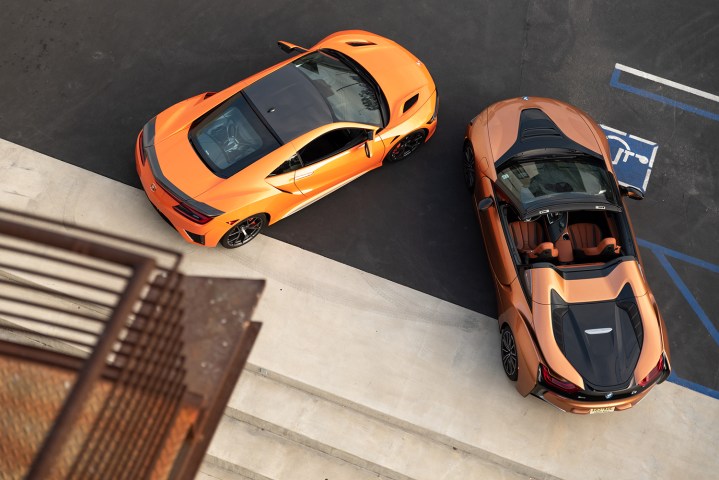
The 2019 BMW i8 and the 2019 Acura NSX may seem like very different machines in your mind’s eye, given that the beemer is most likely to be seen at the new downtown cocktail bar, while the fancy Honda’s natural habitat is the parking lot of a post-IPO dog rental service. But pop on those mental reading glasses and look again. Both cars are two-seaters, both are focused on showcasing cutting-edge technology, and both have outrageous styling. Most importantly, and most surprisingly, both start at the same price. You can drive home in either an i8 or an NSX if you’ve got $155,000 in Dogecoin (or the internet monopoly-money of your choice). So while you might not initially think of cross-shopping these two vehicles, they are actually playing in the same league. Therefore, let’s put them head-to-head and see who comes out the winner. The answer may surprise you. Or not. I’m not in your head.
Judging a book by its cover
While you might not initially think of cross-shopping these two vehicles, they are actually playing in the same league.
Both cars look the part of $155k+ supercars, but they go about their visuals in very different ways. The i8, and especially the roadster we tested in this beautiful E-Copper hue, looks like a car from the near future – say 2030. The i8 is all swoops and curves, and it is often difficult to tell where distinct panels start and end. It looks like nothing else on the road, in the best possible way. The Acura, on the other hand, looks like an amalgam of various Ferraris, Hondas, and even a hint of Corvette. It’s like you asked an AI to generate a supercar. It is certainly handsome and eye-catching, but never distinctive enough to really grab your imagination. A win on exterior styling must go to the i8.
It’s what’s inside that counts
Things are reversed on the interior. The BMW feels fancier than a 3-series but doesn’t quite deliver your $155,000 worth of luxury or materials. It’s such a letdown to see so beautiful a car, to operate its amazing swan doors, and then plop into a ho-hum interior that is all-too contemporary. The designers took such stylistic chances on the body, why couldn’t they do the same with the materials and surfaces here? Especially when the interior of the down market i3 is so much more futuristic with its floating screens and matte wood trim. The one high-point on the i8 would be the uncured carbon fiber cloth accents that are used throughout the cabin.
- 1. 2019 Acura NSX
- 2. 2019 BMW i8
The NSX shines inside, with a sporty cockpit, an entertaining digital cluster screen, and an always-at-hand drive mode selector knob right below the radio. It just feels like so much more of a spaceship when you’re inside the Acura. The materials are more upmarket, the craftsmanship is obvious, and the small details are all on point. The major gripe here is the stereo’s volume control, which is a touch-screen spectrum rather than a simple rotary knob. It was a major pain and never failed to distract or frustrate me. On the same note is the shocking use of Honda parts-bin infotainment graphics. I understand you don’t want to build a whole new software for Acura, but at least give Acura, and especially the NSX, elevated graphics and animations. Still, interior styling is an easy win for the NSX.
All that glitters is tech
Let us put aesthetics aside, for they are subjective and utterly unique for each person. The real reason why these two cars are so interesting to compare back-to-back is because they both use the same technology and layout in utterly opposing ways. It’s like the BMW and Acura are using the same letters and words, but they arrive at completely different languages. For standard features, each comes with parking assist, LED lights, rain-sensing wipers, an electric and internal combustion hybrid system, two-zone climate control, and all-wheel drive. Both are notable for their lack of other fairly standard technology, like adaptive cruise control or high-speed emergency braking. To compensate for these, the passenger cell of the BMW is a full carbon-reinforced plastic cage, while the NSX frame uses something called ablation casting. Just to go all-in on the fabrication dorkery, the Acura’s ultra-slim A pillars are “crafted using an innovative, 3D bent-and-quenched fabrication process that produces ultra-high tensile strength.” No, I have no idea what any of that means either but it’s enough to give the NSX the win for technology.
Tell us how they drive!
Now, in the above section I rushed over their respective hybrid systems. That was rather cheeky of me, because the hybrid systems of these two cars is really what is most interesting between the two and shows the vast differences in driving styles that hybrid technology can enable. It is a fact that they are both hybrid cars. It is also a fact that each car uses its hybrid system for completely opposing purposes.
The BMW i8 is much more of the traditional hybrid, generally using its electric motor for fuel economy gains and otherwise trying to save this floating blue and green marble of ours. With a 3-cylinder engine in the rear and an electric motor up front combining to 369hp, the i8 is certainly not an out-and-out sports car. I am happy to report, however, that it will get aggressive when poked and prodded. The steering feel is ultralight at anything other than freeway speeds, but the car will happily change directions aggressively and confidently. It is certainly a fun car to drive, akin to a hybrid go-kart. The limits are eventually reached though, and the i8 is clearly not designed, sprung, or engined to provide thrills first and foremost.
This is a hybrid application that shows us what the future can bring to the automotive hobby.
The new Acura NSX is a completely different ball game. Yes, it’s technically a hybrid. But that’s like saying that Nicholas Cage is technically an actor. – factually true but the statement misses everything important. See, the 2019 NSX uses it’s three electric motor and six-cylinder gasoline engine hybrid system not for ecological purposes, but for pure, unadulterated fun. With a combined 573 horsepower and 476lb-ft of torque, the electric motors are put into service filling the gaps where the internal combustion engine is at its most disadvantaged. What you get is electric power coming in during gear changes, for off-the-line grunt, and providing instant torque regardless of the vehicle’s speed or the gear selected. The deployment of the hybrid system in the NSX is like turning the Green Peace boat into a party yacht. The sensation is revolutionary. This is a hybrid application that shows us what the future can bring to the automotive hobby.

Most hobbyists and sports-car aficionados look at the Prius and other hybrids like Typhoid Mary. The fear is they will spread their plague of vanilla eco-driving to every corner of the automotive universe and ruin the driving hobby. But what the LaFerrari, Porsche 918 Spyder, McLaren P1, and now the much more attainable Acura NSX make clear is that new technologies can also benefit your experience and the pleasure of driving – even electric technologies.
The BMW i8 is a fun car that can be sporty. The Acura NSX is a sports car, full stop.
It is frankly shocking that the Acura NSX is only $155,000. This car that has supercar technology, exotic-embarrassing performance, and Japanese reliability is the trifecta of every gearhead’s and technologist’s dreams. If you want something else in this price range with the same or better 0-60 time of 3.1 sec, you’ll have to climb into a quaintly large-engined AMG GT R or the anachronistic 911 Turbo. If you want to belong in the 2020s, you’ve got to have an NSX.
The Acura is no slouch on handling either. With torque vectoring done by the two front electric motors, turn-in is beyond immediate. In practice, the twin motors direct torque to each front wheel independently in order to take advantage of each tire’s available traction. So if you’re on dry surfaces with plenty of grip, you get to enjoy more power than you know what to do with. While pushing the car hard on canyon roads, there were several times where I overcooked a corner entry and was sure I was about to have a “grip malfunction.” Instead, the NSX easily breezed through an advised 25mph corner with absolutely no drama. Escalating this pattern again and again, it was clear that I was never anywhere near this car’s limits. The BMW i8 is a fun car that can be sporty. The Acura NSX is a sports car, full stop. Driving dynamics is an easy win for the Acura.
And the winner is…
Overall, it’s just shocking that these cars are actually the same price. The 2019 NSX is leaps and bounds the better car, and anyone who walks past an Acura dealer to get into a BMW i8 is making a massive mistake. If you squint and back up a bit, you can almost see how a technological luxury future car like the i8 is worth $155k. The NSX, however, is such a bargain at this price that it’s unbelievable they are having trouble selling them. Stop whatever you are doing, cash out your 401k, and get yourself an NSX. You can send your thank-you cards to me at any time. Or even better, wait a bit for the rumored R-type version coming soon.









